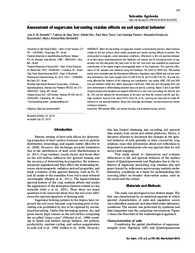Assessment of sugarcane harvesting residue effects on soil spectral behavior
Assessment of sugarcane harvesting residue effects on soil spectral behavior
Autoria: DEMATTÊ, J. A. M.; TERRA, F. da S.; OTTO, R.; TOMA, R. S.; PEREIRA, L. H.; NASCIMENTO, A. F. do; BORTOLETTO, M. A. M.
Resumo: When the harvesting of sugarcane involves a mechanized process, plant residues remain on the soil surface, which makes proximal and remote sensing difficult to monitor. This study aimed to evaluate, under laboratory conditions, differences in the soil spectral behavior of surface layers Quartzipsamment and Hapludox soil classes due to increasing levels of sugarcane?s dry (DL) and green (GL) leaf cover on the soil. Soil cover was quantified by supervised classification of the digital images (photography) taken of the treatments. The spectral reflectance of the samples was obtained using the FieldSpec Pro (350 to 2500 nm). TM-Landsat bands were simulated and the Normalized Difference Vegetation Index (NDVI) and soil line were also determined. Soil cover ranged from 0 to 89 % for DL and 0 to 80 % for GL. Dry leaf covering affected the features of the following soil constituents: iron oxides (480, 530 and 900 nm) and kaolinite (2200 nm). Water absorption (1400 and 1900 nm) and chlorophyll (670 nm) were determinant in differentiating between bare soil and GL covering. Bands 3 and 4 and NDVI showed pronounced variations as regards differences in soil cover percentage for both DL and GL. The soil line allowed for discrimination of the bare soil from the covered soil (DL and GL). High resolution sensors from about 50 % of the DL or GL covering are expected to reveal differences in soil spectral behavior. Above this coverage percentage, soil assessment by remote sensing is impaired.
Ano de publicação: 2016
Tipo de publicação: Artigo de periódico
Unidade: Embrapa Agrossilvipastoril
Palavras-chave: NDVI, Soil line, Soil proximal sensing, Soil remote sensing, TM-Landsat
Observações
1 - Por padrão são exibidas publicações dos últimos 20 anos. Para encontrar publicações mais antigas, configure o filtro ano de publicação, colocando o ano a partir do qual você deseja encontrar publicações. O filtro está na coluna da esquerda na busca acima.
2 - Para ler algumas publicações da Embrapa (apenas as que estão em formato ePub), é necessário ter, no celular ou computador, um desses softwares gratuitos. Sistemas Android: Google Play Livros; IOS: iBooks; Windows e Linux: software Calibre.
Acesse outras publicações
Acesse a Base de Dados da Pesquisa Agropecuária (BDPA) para consultar o acervo completo das bibliotecas da Embrapa.

